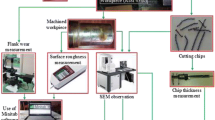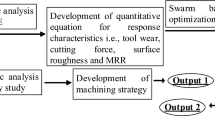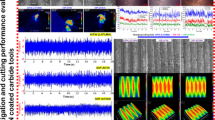Abstract
This research work focus on dry finishing (turning) of AA7075. Newly, emerging alloy target–based ternary PVD–coated tool inserts are compared with non-alloy target–based binary and ternary-coated tool inserts. The coatings include novel alloy target coatings TiAlN (80:20), TiAlN (70:30), and TiAlN (50:50) and non-alloy target coatings TiN and TiCN. One uncoated and five coated tungsten carbide (WC) inserts are analyzed for maximum tool life and minimum surface roughness in dry machining (finish turning) process. Depth of cut, feed rate, and cutting speed are operational parameters optimized against performance parameters (tool life and surface roughness) using a two-stage design of experiment approach. Initial experiments are carried out using L18 (6133) special orthogonal array. General linear model (GLM), linear regression model (LR), and stepwise forward regression model (SFR) are used for analysis. Among alloy target–based PVD–coated tool inserts, TiAlN (50:50) and TiAlN (70:30) performed better in terms of tool life and surface roughness respectively. The TiN-coated tool insert is found as overall superior performing tool insert considering the finished products roughness concerns of aero industry. The optimized solution for TiN is obtained by designing a full factorial experimental configuration. At low feed rate and low cutting speed, high feed rate and low cutting speed, and high feed rate and high cutting speed, approximately 45%, 47%, and 29% higher surface finish can be obtained respectively. Similarly, at low feed rate and low cutting speed and high feed rate and medium cutting speed, approximately 136% and 146% longer tool life can be obtained respectively. A combined saving, i.e., 27% high surface finish, 32% longer tool life and 16% higher material removal rate, can be obtained for optimized setting. Comparing the optimized results with L18 experiments, the optimized solution can give approximately 42% higher surface finish and above 300% longer tool life. Results are discussed on the basis of response surfaces, scanning electron microscopy, and chip roughness profile.















Similar content being viewed by others
Abbreviations
- AA7075:
-
Aluminum alloy 7075
- WC:
-
Tungsten carbide
- TiN:
-
Titanium nitride
- TiCN:
-
Titanium carbo nitride
- TiAlN (80:20):
-
Titanium aluminum nitride produced from alloy target with 80% titanium and 20% aluminum
- TiAlN (70:30):
-
Titanium aluminum nitride produced from alloy target with 70% titanium and 30% aluminum
- TiAlN (50:50):
-
Titanium aluminum nitride produced from alloy target with 50% titanium and 50% aluminum
- Insert 1:
-
Uncoated tungsten carbide tool insert
- Insert 2:
-
TiN coated tungsten carbide tool insert
- Insert 3:
-
TiCN coated tungsten carbide tool insert
- Insert 4:
-
TiAlN (80:20) coated tungsten carbide tool insert
- Insert 5:
-
TiAlN (70:30) coated tungsten carbide tool insert
- Insert 6:
-
TiAlN (50:50) coated tungsten carbide tool insert
- GLM:
-
General linear model
- LR:
-
Linear regression
- SFR:
-
Stepwise forward regression
- CMM:
-
Coordinate measuring machine
- PVD:
-
Physical vapor deposition
- DOC:
-
Depth of cut
- FR:
-
Feed rate
- CS:
-
Cutting speed
- CR:
-
Confirmatory run
- FS:
-
Factor selection
- RSM:
-
Response surface methodology
- SEM:
-
Scanning electron microscopy
- BUE:
-
Build-up edges
- DOE:
-
Design of experiments
- MRR:
-
Material removal rate
References
Zhang Y et al (2022) Corrosion of aluminum alloy 7075 induced by marine Aspergillus terreus with continued organic carbon starvation. npj Mater Degrad 6(1):1–12
Zhou B et al (2021) Microstructure evolution of recycled 7075 aluminum alloy and its mechanical and corrosion properties. J Alloys Compd 879:160407
Kumar KN et al (2018) Comparative approaches for fatigue life estimation of aluminium alloy for aerospace applications. Int J Veh Struct Syst 10(4)
Sivaraman P et al (2021) Development of aluminum based AA 2014 and AA 7075 dissimilar metals for aerospace applications. Mater Today: Proc 37:522–526
Zhou B, Liu B, Zhang S (2021) The advancement of 7xxx series aluminum alloys for aircraft structures: A review. Metals 11(5):718
Gupta MK et al (2022) Cutting forces and temperature measurements in cryogenic assisted turning of AA2024-T351 alloy: an experimentally validated simulation approach. Measurement 188:110594
Sahoo SP, S.J.A.J.f.S. Datta, and Engineering (2020) Dry machining performance of AA7075-T6 alloy using uncoated carbide and MT-CVD TiCN-Al2O3-coated carbide inserts. Arab J Sci Eng 45(11):9777–9791
Musavi SH et al (2022) Performance analysis of developed micro-textured cutting tool in machining aluminum alloy 7075-T6: assessment of tool wear and surface roughness. Int J Adv Manuf Technol 119:3343–3362
Jomaa W, Songmene V, Bocher PJM (2014) Surface finish and residual stresses induced by orthogonal dry machining of AA7075-T651. Materials 7(3):1603–1624
Nyaboro J et al (2021) Experimental and numerical investigation of the abrasive waterjet machining of aluminum-7075-T6 for aerospace applications. Adv Manuf 9(2):286–303
Rotella G, Franchi R, Del Prete A (2022) Optimization of machining process for improved sustainability. In: Key Engineering Materials. Trans Tech Publ
Çakır A et al (2016) The effect of minimum quantity lubrication under different parameters in the turning of AA7075 and AA2024 aluminium alloys. Int J Adv Manuf Technol 84(9):2515–2521
Musavi SH, Davoodi B, S.A.J.J.o.M.P. Niknam (2018) Environmental-friendly turning of A286 superalloy. J Manuf Process 32:734–743
Ghosh AJJOMPT (2018) Anti-friction and wetting behavior of a new polymer composite coating towards aluminium and dry machining of AA2024 alloy by coated end mills. J Mater Process Technol 252:280–293
Shokrani A, Dhokia V, Newman ST (2012) Environmentally conscious machining of difficult-to-machine materials with regard to cutting fluids. Int J Mach Tools Manuf 57:83–101
Sreejith P (2008) Machining of 6061 aluminium alloy with MQL, dry and flooded lubricant conditions. Mater Lett 62(2):276–278
Pimenov DY et al (2022) Resource saving by optimization and machining environments for sustainable manufacturing: a review and future prospects. Renew Sust Energ Rev 166:112660
Sarikaya M et al (2021) Cooling techniques to improve the machinability and sustainability of light-weight alloys: a state-of-the-art review. J Manuf Process 62:179–201
Sreejith P, Ngoi B (2000) Dry machining: machining of the future. J Mater Process Technol 101(1-3):287–291
Shareef I, Natarajan M, Ajayi OO (2005) Dry machinability of aluminum alloys. World Tribology Congress
Gupta MK et al (2019) Hybrid cooling-lubrication strategies to improve surface topography and tool wear in sustainable turning of Al 7075-T6 alloy. Int J Adv Manuf Technol 101(1):55–69
Sankaranarayanan R, Krolczyk G (2021) A comprehensive review on research developments of vegetable-oil based cutting fluids for sustainable machining challenges. J Manuf Process 67:286–313
Goindi GS, Sarkar P (2017) Dry machining: a step towards sustainable machining–challenges and future directions. J Clean Prod 165:1557–1571
Pattnaik SK et al (2018) Dry machining of aluminum for proper selection of cutting tool: tool performance and tool wear. Int J Adv Manuf Technol 98(1):55–65
Uddin GM et al (2021) Comparative performance analysis of cemented carbide, TiN, TiAlN, and PCD coated inserts in dry machining of Al 2024 alloy. Int J Adv Manuf Technol 112(5):1461–1481
Kumar CS et al (2020) Applicability of DLC and WC/C low friction coatings on Al2O3/TiCN mixed ceramic cutting tools for dry machining of hardened 52100 steel. Ceram Int 46(8):11889–11897
List G et al (2005) Wear behaviour of cemented carbide tools in dry machining of aluminium alloy. Wear 259(7-12):1177–1189
Diniz AE, de Oliveira AJ (2004) Optimizing the use of dry cutting in rough turning steel operations. Int J Mach Tools Manuf 44(10):1061–1067
Bayraktar S (2021) Dry cutting: a sustainable machining technology. In: Sustainable Manufacturing. Elsevier, pp 231–257
Pandey K, Datta S (2022) Performance of Si-doped TiAlxN supernitride coated carbide tool during dry machining of Inconel 718 superalloy. J Manuf Process 84:1258–1273
Badisch E et al (2004) Characterization of tribo-layers on self-lubricating plasma-assisted chemical-vapor-deposited TiN coatings. Thin Solid Films 460(1-2):125–132
Guleryuz CG, Krzanowski JE (2010) Mechanisms of self-lubrication in patterned TiN coatings containing solid lubricant microreservoirs. Surf Coat Technol 204(15):2392–2399
Fernandes F, Oliveira J, Cavaleiro A (2016) Self-lubricating TiSi (V) N thin films deposited by deep oscillation magnetron sputtering (DOMS). Surf Coat Technol 308:256–263
Carou D et al (2014) Experimental investigation on finish intermittent turning of UNS M11917 magnesium alloy under dry machining. Int J Adv Manuf Technol 75(9):1417–1429
Rao KSS, Allamraju KVJMTP (2017) Effect on micro-hardness and residual stress in CNC turning of aluminium 7075 alloy. Mater Today: Proc 4(2):975–981
Manna A, B.J.T.I.J.o.A.M.T. Bhattacharayya (2005) Influence of machining parameters on the machinability of particulate reinforced Al/SiC–MMC. Mater Today: Proc 25:850–856
Lin J, Bhattacharyya D, Lane C (1995) Machinability of a silicon carbide reinforced aluminium metal matrix composite. Wear 181:883–888
Abas M et al (2020) Optimization of machining parameters of aluminum alloy 6026-T9 under MQL-assisted turning process. J Mater Res Technol 9(5):10916–10940
Imbrogno S, Rotella G, Rinaldi S (2020) Surface and subsurface modifications of AA7075-T6 induced by dry and cryogenic high speed machining. Int J Adv Manuf Technol 107(1):905–918
Pugazhenthi A et al (2018) Predicting the effect of machining parameters on turning characteristics of AA7075/TiB2 in situ aluminum matrix composites using empirical relationships. J Braz Soc Mech Sci Eng 40(12):1–15
Bhushan RK (2022) Effect of tool wear on surface roughness in machining of AA7075/10 wt.% SiC composite. Compos Part C: Open Access 8:100254
Lundstedt T et al (1998) Experimental design and optimization. Chemom Intell Lab Syst 42(1-2):3–40
Pawade R, Joshi SS, Brahmankar P (2008) Effect of machining parameters and cutting edge geometry on surface integrity of high-speed turned Inconel 718. Int J Mach Tools Manuf 48(1):15–28
Cakir MC, Ensarioglu C, Demirayak I (2009) Mathematical modeling of surface roughness for evaluating the effects of cutting parameters and coating material. J Mater Process Technol 209(1):102–109
Asiltürk I, Akkuş H (2011) Determining the effect of cutting parameters on surface roughness in hard turning using the Taguchi method. Measurement 44(9):1697–1704
Srikanth D, Rao MS (2015) Application of Taguchi & response surface methodology in optimization for machining of ceramics with abrasive jet machining. Mater Today: Proc 2(4-5):3308–3317
Kanchana J, Prasath V, Krishnaraj V (2019) Multi response optimization of process parameters using grey relational analysis for milling of hardened Custom 465 steel. Procedia Manuf 30:451–458
Çaydaş U, Hascalık A (2008) A study on surface roughness in abrasive waterjet machining process using artificial neural networks and regression analysis method. J Mater Process Technol 202(1-3):574–582
Mandal N et al (2011) Optimization of flank wear using zirconia toughened alumina (ZTA) cutting tool: Taguchi method and Regression analysis. Measurement 44(10):2149–2155
Bhushan RK, Kumar S, Das S (2010) Effect of machining parameters on surface roughness and tool wear for 7075 Al alloy SiC composite. Int J Adv Manuf Technol 50(5):459–469
Bhuiyan M, Choudhury I, Dahari M (2014) Monitoring the tool wear, surface roughness and chip formation occurrences using multiple sensors in turning. J Manuf Syst 33(4):476–487
Azam M et al (2015) Surface roughness modeling using RSM for HSLA steel by coated carbide tools. Int J Adv Manuf Technol 78(5):1031–1041
Villeta M et al (2012) Efficient optimisation of machining processes based on technical specifications for surface roughness: application to magnesium pieces in the aerospace industry. Int J Adv Manuf Technol 60(9):1237–1246
Mishra P et al (2015) Multi-response optimization of process parameters using Taguchi method and grey relational analysis during turning AA 7075/SiC composite in dry and spray cooling environments. Int J Ind Eng Comput 6(4):445–456
Bull S et al (2003) Properties and performance of commercial TiCN coatings Part 1: coating architecture and hardness modelling. Surf Coat Technol 163:499–506
Adesina AY et al (2019) Electrochemical evaluation of the corrosion protectiveness and porosity of vacuum annealed CrAlN and TiAlN cathodic arc physical vapor deposited coatings. Corros Mater 70(9):1601–1616
Uddin GM et al (2019) Experimental investigation of tribo-mechanical and chemical properties of TiN PVD coating on titanium substrate for biomedical implants manufacturing. Int J Adv Manuf Technol 102:1391–1404
Stachowiak GW, Batchelor AW (2013) Engineering tribology. Butterworth-heinemann
Box GE, Hunter JS, Hunter WGJHW-I (2005) Statistics for experimenters: design, discovery and innovation, vol 639. Wiley-Interscience, Hoboken
Alexander DL, Tropsha A, Winkler DA (2015) Beware of R 2: simple, unambiguous assessment of the prediction accuracy of QSAR and QSPR models. J Chem Inf Model 55(7):1316–1322
Kalita K, Shivakoti I, Ghadai RK (2017) Optimizing process parameters for laser beam micro-marking using genetic algorithm and particle swarm optimization. Mater Manuf Process 32(10):1101–1108
Ezazi M et al (2014) Enhancing the tribo-mechanical properties of aerospace AL7075-T6 by magnetron-sputtered Ti/TiN, Cr/CrN & TiCr/TiCrN thin film ceramic coatings. Ceram Int 40(10):15603–15615
Kara F et al (2020) Effect of machinability, microstructure and hardness of deep cryogenic treatment in hard turning of AISI D2 steel with ceramic cutting. J Mater Res Technol 9(1):969–983
Lenzi V et al (2021) Diffusion of silver in titanium nitride: Insights from density functional theory and molecular dynamics. Appl Surf Sci 556:149738
Sumitomo T et al (2005) In-situ formation of self-lubricating tribo-films for dry machinability. Surf Coat Technol 200(5-6):1797–1803
Aizawa T et al (2005) Self-lubrication mechanism via the in situ formed lubricious oxide tribofilm. Wear 259(1-6):708–718
Marousi M et al (2023) Initial tool wear and process monitoring during titanium metal matrix composite machining (TiMMC). J Manuf Process 86:208–220
Chang CL, Yang FC (2018) Technology, Effect of target composition on the microstructural, mechanical, and corrosion properties of TiAlN thin films deposited by high-power impulse magnetron sputtering. Surf Coat Technol 352:330–337
Marigoudar R, Sadashivappa KJMS (2014) Comparison of tool life and surface characteristics of uncoated, coated carbide and ceramic tools during machining of SiC reinforced ZA43 alloy MMC. Mater Sci Technol 30(8):876–887
Khan SA et al (2017) High-feed turning of AISI D2 tool steel using multi-radii tool inserts: tool life, material removed, and workpiece surface integrity evaluation. Mater Manuf Process 32(6):670–677
Naskar A, Chattopadhyay A (2018) Investigation on flank wear mechanism of CVD and PVD hard coatings in high speed dry turning of low and high carbon steel. Wear 396:98–106
Behera B, Ghosh S, Rao P (2016) Wear behavior of PVD TiN coated carbide inserts during machining of Nimonic 90 and Ti6Al4V superalloys under dry and MQL conditions. Ceram Int 42(13):14873–14885
Da Silva W et al (2013) Effect of laser surface modification on the micro-abrasive wear resistance of coated cemented carbide tools. Wear 302(1-2):1230–1240
Lee W, Ratnam M, Ahmad Z (2017) Detection of chipping in ceramic cutting inserts from workpiece profile during turning using fast Fourier transform (FFT) and continuous wavelet transform (CWT). Precis Eng 47:406–423
Lee W, Ratnam M, Ahmad Z (2016) In-process detection of chipping in ceramic cutting tools during turning of difficult-to-cut material using vision-based approach. Int J Adv Manuf Technol 85(5):1275–1290
Lv J et al (2018) An investigation into methods for predicting material removal energy consumption in turning. J Clean Prod 193:128–139
Shokrani A, Dhokia V, Newman ST (2016) Investigation of the effects of cryogenic machining on surface integrity in CNC end milling of Ti–6Al–4 V titanium alloy. J Manuf Process 21:172–179
Asiltürk I, Akkuş HJM (2011) Determining the effect of cutting parameters on surface roughness in hard turning using the Taguchi method. Measurement 44(9):1697–1704
Rafai NH, Islam MN (2009) An investigation into dimensional accuracy and surface finish achievable in dry turning. Mach Sci Technol 13(4):571–589
Sajjad U et al (2021) Enhancing corrosion resistance of Al 5050 alloy based on surface roughness and its fabrication methods; an experimental investigation. J Mater Res Technol 11:1859–1867
Ciesielski PN et al (2014) Effect of mechanical disruption on the effectiveness of three reactors used for dilute acid pretreatment of corn stover Part 2: Morphological and structural substrate analysis. Biotechnol Biofuels 7(1):1–12
Hasan MF, Wang J, Berndt CC (2013) Effect of power and stand-off distance on plasma sprayed hydroxyapatite coatings. Mater Manuf Process 28(12):1279–1285
Şap S et al (2022) Investigation of the effects of cooling and lubricating strategies on tribological characteristics in machining of hybrid composites. Lubricants 10(4):63
Roy P et al (2009) Machinability study of pure aluminium and Al–12% Si alloys against uncoated and coated carbide inserts. Int J Refract Met Hard Mater 27(3):535–544
Gangopadhyay S et al (2010) Effect of cutting speed and surface chemistry of cutting tools on the formation of BUL or BUE and surface quality of the generated surface in dry turning of AA6005 aluminium alloy. Mach Sci Technol 14(2):208–223
Djebara A et al (2013) Dust emission during dry machining of aeronautic aluminum alloys. In: Conference on Aeronautics Sciences (ICAS). ICAS
Author information
Authors and Affiliations
Corresponding author
Ethics declarations
Competing interests
The authors declare no competing interests.
Additional information
Publisher’s note
Springer Nature remains neutral with regard to jurisdictional claims in published maps and institutional affiliations.
Rights and permissions
Springer Nature or its licensor (e.g. a society or other partner) holds exclusive rights to this article under a publishing agreement with the author(s) or other rightsholder(s); author self-archiving of the accepted manuscript version of this article is solely governed by the terms of such publishing agreement and applicable law.
About this article
Cite this article
Zubair, S.W.H., Arafat, S.M., Khan, S.A. et al. Dry finishing turning of AA7075 with binary and ternary nitrides and carbides ceramic-coated tools. Int J Adv Manuf Technol 129, 65–87 (2023). https://doi.org/10.1007/s00170-023-12105-6
Received:
Accepted:
Published:
Issue Date:
DOI: https://doi.org/10.1007/s00170-023-12105-6




